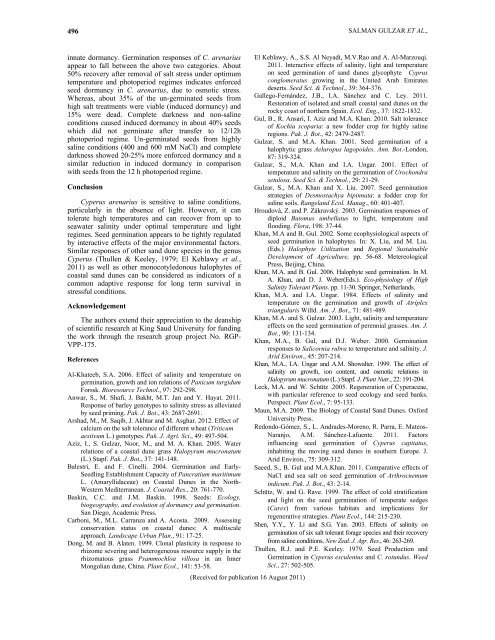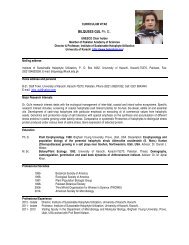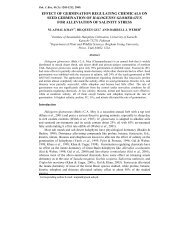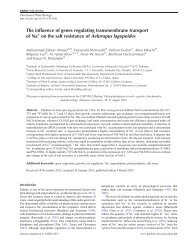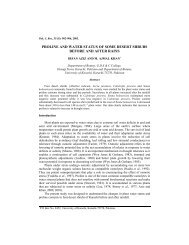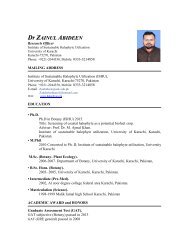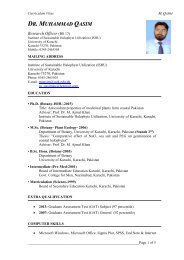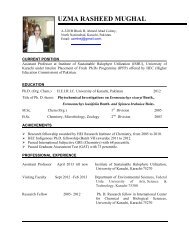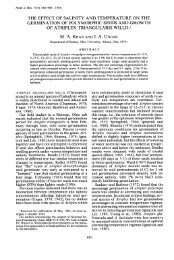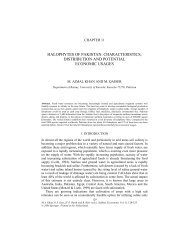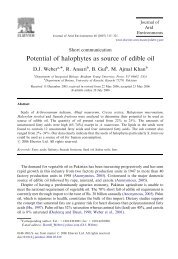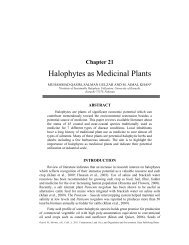seed germination ecology of cyperus arenarius â a ... - ResearchGate
seed germination ecology of cyperus arenarius â a ... - ResearchGate
seed germination ecology of cyperus arenarius â a ... - ResearchGate
You also want an ePaper? Increase the reach of your titles
YUMPU automatically turns print PDFs into web optimized ePapers that Google loves.
496<br />
SALMAN GULZAR ET AL.,<br />
innate dormancy. Germination responses <strong>of</strong> C. <strong>arenarius</strong><br />
appear to fall between the above two categories. About<br />
50% recovery after removal <strong>of</strong> salt stress under optimum<br />
temperature and photoperiod regimes indicates enforced<br />
<strong>seed</strong> dormancy in C. <strong>arenarius</strong>, due to osmotic stress.<br />
Whereas, about 35% <strong>of</strong> the un-germinated <strong>seed</strong>s from<br />
high salt treatments were viable (induced dormancy) and<br />
15% were dead. Complete darkness and non-saline<br />
conditions caused induced dormancy in about 40% <strong>seed</strong>s<br />
which did not germinate after transfer to 12/12h<br />
photoperiod regime. Un-germinated <strong>seed</strong>s from highly<br />
saline conditions (400 and 600 mM NaCl) and complete<br />
darkness showed 20-25% more enforced dormancy and a<br />
similar reduction in induced dormancy in comparison<br />
with <strong>seed</strong>s from the 12 h photoperiod regime.<br />
Conclusion<br />
Cyperus <strong>arenarius</strong> is sensitive to saline conditions,<br />
particularly in the absence <strong>of</strong> light. However, it can<br />
tolerate high temperatures and can recover from up to<br />
seawater salinity under optimal temperature and light<br />
regimes. Seed <strong>germination</strong> appears to be tightly regulated<br />
by interactive effects <strong>of</strong> the major environmental factors.<br />
Similar responses <strong>of</strong> other sand dune species in the genus<br />
Cyperus (Thullen & Keeley, 1979; El Keblawy et al.,<br />
2011) as well as other monocotyledonous halophytes <strong>of</strong><br />
coastal sand dunes can be considered as indicators <strong>of</strong> a<br />
common adaptive response for long term survival in<br />
stressful conditions.<br />
Acknowledgement<br />
The authors extend their appreciation to the deanship<br />
<strong>of</strong> scientific research at King Saud University for funding<br />
the work through the research group project No. RGP-<br />
VPP-175.<br />
References<br />
Al-Khateeb, S.A. 2006. Effect <strong>of</strong> salinity and temperature on<br />
<strong>germination</strong>, growth and ion relations <strong>of</strong> Panicum turgidum<br />
Forssk. Bioresource Technol., 97: 292-298.<br />
Anwar, S., M. Shafi, J. Bakht, M.T. Jan and Y. Hayat. 2011.<br />
Response <strong>of</strong> barley genotypes to salinity stress as alleviated<br />
by <strong>seed</strong> priming. Pak. J. Bot., 43: 2687-2691.<br />
Arshad, M., M. Saqib, J. Akhtar and M. Asghar. 2012. Effect <strong>of</strong><br />
calcium on the salt tolerance <strong>of</strong> different wheat (Triticum<br />
aestivum L.) genotypes. Pak. J. Agri. Sci., 49: 497-504.<br />
Aziz, I., S. Gulzar, Noor, M., and M. A. Khan. 2005. Water<br />
relations <strong>of</strong> a coastal dune grass Halopyrum mucronatum<br />
(L.) Stapf. Pak. J. Bot., 37: 141-148.<br />
Balestri, E. and F. Cinelli. 2004. Germination and Early-<br />
Seedling Establishment Capacity <strong>of</strong> Pancratium maritimum<br />
L. (Amaryllidaceae) on Coastal Dunes in the North-<br />
Western Mediterranean. J. Coastal Res., 20: 761-770.<br />
Baskin, C.C. and J.M. Baskin. 1998. Seeds: Ecology,<br />
biogeography, and evolution <strong>of</strong> dormancy and <strong>germination</strong>.<br />
San Diego, Academic Press.<br />
Carboni, M., M.L. Carranza and A. Acosta. 2009. Assessing<br />
conservation status on coastal dunes: A multiscale<br />
approach. Landscape Urban Plan., 91: 17-25.<br />
Dong, M. and B. Alaten. 1999. Clonal plasticity in response to<br />
rhizome severing and heterogeneous resource supply in the<br />
rhizomatous grass Psammochloa villosa in an Inner<br />
Mongolian dune, China. Plant Ecol., 141: 53-58.<br />
(Received for publication 16 August 2011)<br />
El Keblawy, A., S.S. Al Neyadi, M.V.Rao and A. Al-Marzouqi.<br />
2011. Interactive effects <strong>of</strong> salinity, light and temperature<br />
on <strong>seed</strong> <strong>germination</strong> <strong>of</strong> sand dunes glycophyte Cyprus<br />
conglomeratus growing in the United Arab Emirates<br />
deserts. Seed Sci. & Technol., 39: 364-376.<br />
Gallego-Fernández, J.B., I.A. Sánchez and C. Ley. 2011.<br />
Restoration <strong>of</strong> isolated and small coastal sand dunes on the<br />
rocky coast <strong>of</strong> northern Spain. Ecol. Eng., 37: 1822-1832.<br />
Gul, B., R. Ansari, I. Aziz and M.A. Khan. 2010. Salt tolerance<br />
<strong>of</strong> Kochia scoparia: a new fodder crop for highly saline<br />
regions. Pak. J. Bot., 42: 2479-2487.<br />
Gulzar, S. and M.A. Khan. 2001. Seed <strong>germination</strong> <strong>of</strong> a<br />
halophytic grass Aeluropus lagopoides. Ann. Bot.-London,<br />
87: 319-324.<br />
Gulzar, S., M.A. Khan and I.A. Ungar. 2001. Effect <strong>of</strong><br />
temperature and salinity on the <strong>germination</strong> <strong>of</strong> Urochondra<br />
setulosa. Seed Sci. & Technol., 29: 21-29.<br />
Gulzar, S., M.A. Khan and X. Liu. 2007. Seed <strong>germination</strong><br />
strategies <strong>of</strong> Desmostachya bipinnata: a fodder crop for<br />
saline soils. Rangeland Ecol. Manag., 60: 401-407.<br />
Hroudová, Z. and P. Zákravský. 2003. Germination responses <strong>of</strong><br />
diploid Butomus umbellatus to light, temperature and<br />
flooding. Flora, 198: 37-44.<br />
Khan, M.A and B. Gul. 2002. Some ecophysiological aspects <strong>of</strong><br />
<strong>seed</strong> <strong>germination</strong> in halophytes. In: X. Liu, and M. Liu.<br />
(Eds.) Halophyte Utilization and Regional Sustainable<br />
Development <strong>of</strong> Agriculture, pp. 56-68. Metereological<br />
Press, Beijing, China.<br />
Khan, M.A. and B. Gul. 2006. Halophyte <strong>seed</strong> <strong>germination</strong>. In M.<br />
A. Khan, and D. J. Weber(Eds.). Eco-physiology <strong>of</strong> High<br />
Salinity Tolerant Plants. pp. 11-30. Springer, Netherlands.<br />
Khan, M.A. and I.A. Ungar. 1984. Effects <strong>of</strong> salinity and<br />
temperature on the <strong>germination</strong> and growth <strong>of</strong> Atriplex<br />
triangularis Willd. Am. J. Bot., 71: 481-489.<br />
Khan, M.A. and S. Gulzar. 2003. Light, salinity and temperature<br />
effects on the <strong>seed</strong> <strong>germination</strong> <strong>of</strong> perennial grasses. Am. J.<br />
Bot., 90: 131-134.<br />
Khan, M.A., B. Gul, and D.J. Weber. 2000. Germination<br />
responses to Salicornia rubra to temperature and salinity. J.<br />
Arid Environ., 45: 207-214.<br />
Khan, M.A., I.A. Ungar and A.M. Showalter. 1999. The effect <strong>of</strong><br />
salinity on growth, ion content, and osmotic relations in<br />
Halopyrum mucronatum (L.) Stapf. J. Plant Nutr., 22: 191-204.<br />
Leck, M.A. and W. Schütz .2005. Regeneration <strong>of</strong> Cyperaceae,<br />
with particular reference to <strong>seed</strong> <strong>ecology</strong> and <strong>seed</strong> banks.<br />
Perspect. Plant Ecol., 7: 95-133.<br />
Maun, M.A. 2009. The Biology <strong>of</strong> Coastal Sand Dunes. Oxford<br />
University Press.<br />
Redondo-Gómez, S., L. Andrades-Moreno, R. Parra, E. Mateos-<br />
Naranjo, A.M. Sánchez-Lafuente. 2011. Factors<br />
influencing <strong>seed</strong> <strong>germination</strong> <strong>of</strong> Cyperus capitatus,<br />
inhabiting the moving sand dunes in southern Europe. J.<br />
Arid Environ., 75: 309-312.<br />
Saeed, S., B. Gul and M.A.Khan. 2011. Comparative effects <strong>of</strong><br />
NaCl and sea salt on <strong>seed</strong> <strong>germination</strong> <strong>of</strong> Arthrocnemum<br />
indicum. Pak. J. Bot., 43: 2-14.<br />
Schütz, W. and G. Rave. 1999. The effect <strong>of</strong> cold stratification<br />
and light on the <strong>seed</strong> <strong>germination</strong> <strong>of</strong> temperate sedges<br />
(Carex) from various habitats and implications for<br />
regenerative strategies. Plant Ecol., 144: 215-230.<br />
Shen, Y.Y., Y. Li and S.G. Yan. 2003. Effects <strong>of</strong> salinity on<br />
<strong>germination</strong> <strong>of</strong> six salt tolerant forage species and their recovery<br />
from saline conditions, New Zeal. J. Agr. Res., 46: 263-269.<br />
Thullen, R.J. and P.E. Keeley. 1979. Seed Production and<br />
Germination in Cyperus esculentus and C. rotundus. Weed<br />
Sci., 27: 502-505.


